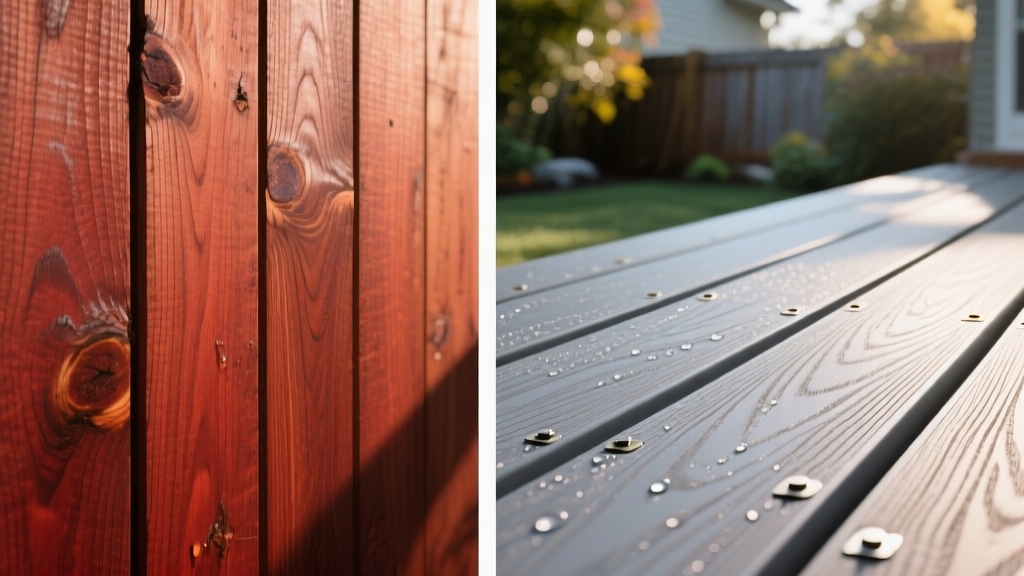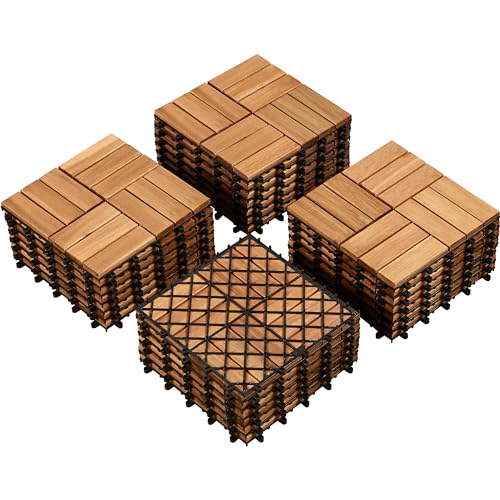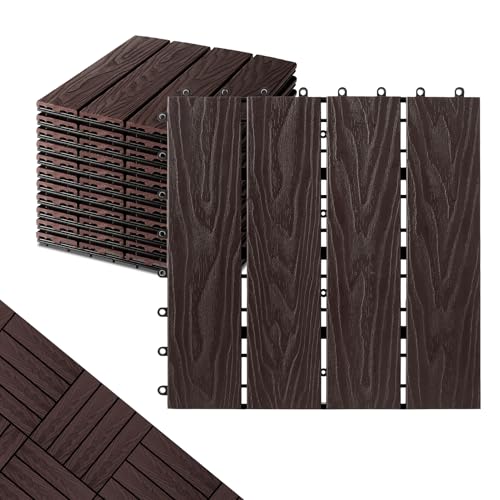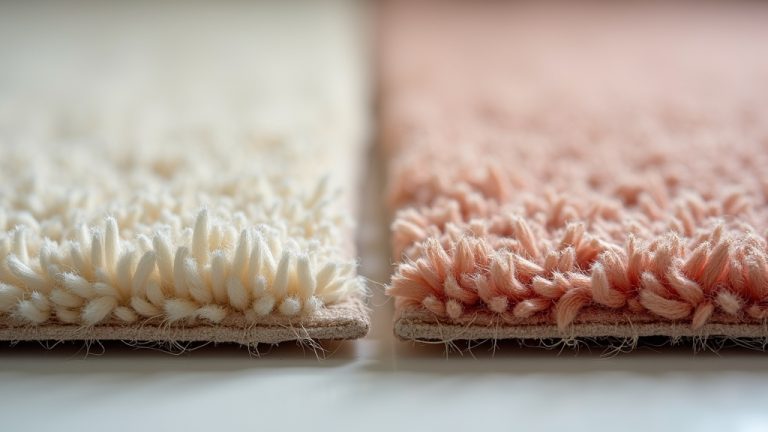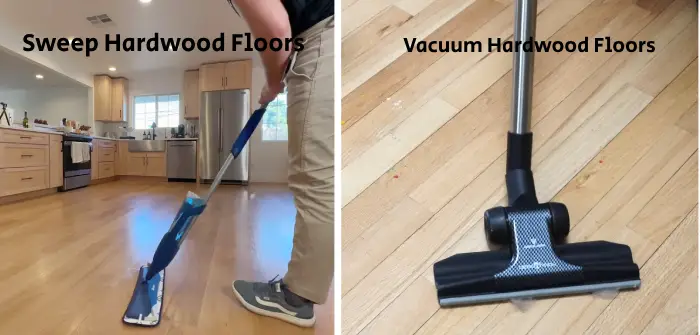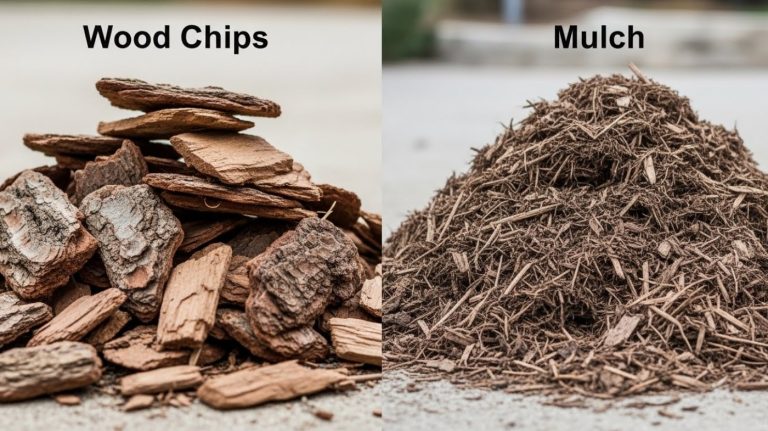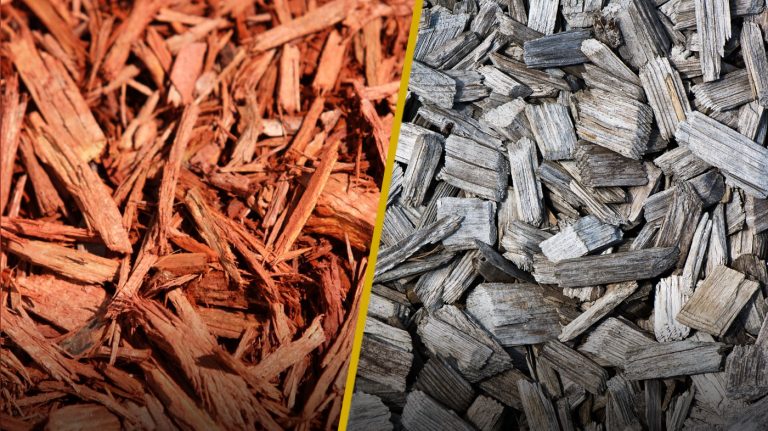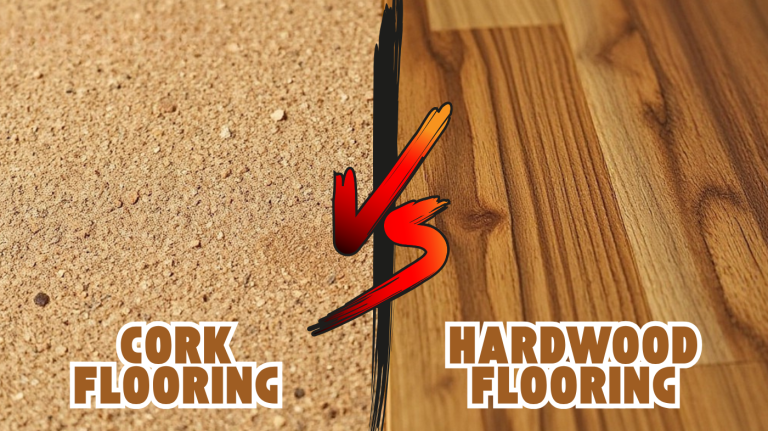Hardwood vs Composite Decking: Best Material Choice
If you want a deck that offers rich, natural wood grain with evolving character, hardwood’s for you but it demands regular sealing and repairs. Composite decking costs more upfront but delivers superior durability, low maintenance, and engineered resistance to UV, moisture, and pests.
Its variety of colors and textures mimic wood while providing safer, cooler surfaces. Balancing aesthetics, longevity, and upkeep will guide your choice. Exploring these factors further can clarify which fits your outdoor vision best.
- Premium Acacia Hardwood Quality – These floor tiles are made from 100% solid Acacia wood, known…
- Easy Snap-In Installation: Upgrade your outdoor space effortlessly with our interlocking deck tiles….
- Long-Lasting Wood Strength: Designed for durability, these interlocking deck tiles resist warping…
- 100% FSC CERTIFIED MATERIAL: The interlocking deck tiles are made from responsibly sourced, FSC…
- SUSTAINABLE BEAUTY, ENDURING STRENGTH: Wood plastic composite deck tiles combine the strength of…
- EASY INSTALL, DIY FUN: The composite decking features an interlocking mechanism, easily snapped…
Key Takeaways
- Composite decking offers low maintenance with resistance to warping, rot, and insects, unlike hardwood requiring annual sealing and staining.
- Hardwood provides authentic natural wood grain and rich textures that develop character over time, while composite mimics wood with diverse color options.
- Composite decking has higher upfront costs but longer lifespan and less upkeep, whereas hardwood has lower initial cost but higher ongoing maintenance.
- Composite surfaces are splinter-free and non-slip, enhancing safety and comfort compared to hardwood’s smooth grain that may splinter.
- Hardwood is more environmentally friendly as a carbon sink if FSC-certified, but composite uses recycled materials and lasts longer, reducing replacements.
Hardwood Decking vs Composite: Side-by-Side Comparison
| Feature | Hardwood Decking | Composite Decking |
|---|---|---|
| Initial Cost | $15-$25 per sq ft (pressure-treated) $25-$45 per sq ft (premium) | $30-$60 per sq ft installed $9-$16 materials only |
| Lifespan | 15-25 years (with proper care) Up to 50+ years (premium hardwoods) | 25-30 years standard Up to 50 years (premium) |
| Maintenance | High maintenance Annual cleaning, sealing, staining 30-40 hours yearly | Low maintenance Biannual cleaning only Minimal upkeep required |
| Weather Resistance | Requires frequent sealing Prone to warping and rot | Superior weather resistance UV-resistant coatings included |
| Aesthetic Appeal | Natural wood grain Authentic texture that evolves Rich, organic appearance | Consistent color palette Variety of textures Mimics wood appearance |
| Environmental Impact | Lower production emissions Renewable resource | Uses recycled materials Higher production energy |
| Safety Features | Can become slippery when wet Potential for splintering | Enhanced slip resistance Splinter-free surface |
| Heat Retention | Stays cooler underfoot More comfortable barefoot | Can get hot in direct sun Some varieties stay cooler |
| Repair Difficulty | Labor-intensive repairs Requires sanding, staining | Easy repairs Heat guns, fillers work well |
| ROI/Resale Value | Higher immediate ROI (60%+) Appeals to traditional buyers | Slightly lower percentage $9,325 average value added |
Cost Comparison Between Hardwood and Composite Decking
While composite decking demands a higher initial investment, ranging from $30 to $60 per square foot installed, its upfront costs reflect superior durability and minimal maintenance needs compared to wood. Composite materials alone cost between $9 and $16 per square foot, considerably more than pressure-treated wood ($15-$25) or cedar ($4-$9).
Additionally, composite decking offers excellent weather and pest resistance, reducing concerns related to rot and insect damage. Installation requires specialized fasteners tailored to the decking type, adding to expenses but ensuring structural integrity.
Proper selection of moisture-resistant adhesives during installation can further enhance the longevity of composite decks. Conversely, wood framing offers a budget-friendly foundation at $3 to $8 per square foot.
Though wood decking appears cost-effective initially, it necessitates ongoing staining, sealing, and repairs, increasing lifetime costs. Composite’s higher upfront price incorporates advanced material technology and design versatility, which offset frequent maintenance demands and elevate long-term value.
Durability and Lifespan of Decking Materials
You’ll find hardwood decks like Ipe offer exceptional longevity, often surpassing 50 years with proper care. Their natural density and oils contribute to moisture resistance that helps prevent warping and decay.
Meanwhile, composite decks typically last 25 to 30 years, benefiting from engineered resistance to fading and pests. Material density, natural oils, and UV inhibitors play critical roles in resisting rot, insect damage, and weathering.
Proper maintenance such as sealing and cleaning is essential to maximize the lifespan of both hardwood and composite decking materials.
Longevity Comparison
Because decking materials vary widely in composition and maintenance needs, their longevity differs considerably. Composite decking, with engineered polymer capping, resists weathering, rot, and insects, lasting 25–30 years or up to 50 years for premium types, with minimal upkeep.
It also contains UV-resistant coatings that help maintain color and prevent fading over time. Additionally, composite materials typically involve low energy use in production, reducing environmental impact.
Hardwood decks require rigorous care, including annual sealing and refinishing, and typically last 10–25 years. Softwoods generally endure 10–15 years but need frequent treatments.
| Decking Type | Average Lifespan |
|---|---|
| Composite | 25–30 years (up to 50) |
| Hardwood | 15–25 years |
| Softwood | 10–15 years |
| Maintenance Need | Low (Composite) vs High (Wood) |
Choosing composite reduces long-term maintenance and replacement cycles, making it a more durable investment.
Material Resistance Factors
When selecting decking materials, understanding their resistance to environmental factors is essential for ensuring durability and extending lifespan. Composite decking integrates UV-resistant coatings that prevent fading and discoloration, while its non-absorbent nature averts swelling, warping, and rot, common issues with wood exposed to moisture.
Additionally, composite decking typically lasts 25-30 years, significantly outlasting wood options when properly maintained. Its construction is somewhat analogous to engineered hardwood in providing layered durability and resistance.
Wood decking, even hardwoods like cedar, demands frequent sealing to combat UV degradation and moisture damage. Composite materials also resist rot and insect infestation thanks to their plastic-wood fiber blend, reducing hidden structural failures typical in wood decks.
Additionally, capped composite surfaces excel in scratch, stain, and abrasion resistance, maintaining aesthetic integrity under heavy use. Their inherent slip resistance, validated by rigorous testing, enhances safety in wet conditions.
Maintenance Impact
Although both wood and composite decking require maintenance to preserve their durability, the frequency, labor intensity, and long-term impact on lifespan differ considerably. Proper maintenance, such as regular sweeping with a soft-bristled broom, helps prevent surface damage and prolongs deck life.
Wood demands annual cleaning, staining, and sealing, consuming 30-40 hours yearly and risking warping or rot if neglected. In fact, pressure-treated wood decks are approximately 40% cheaper than composite decks, making them attractive despite the maintenance demands.
Composite requires minimal upkeep—just sweeping and biannual cleaning—extending lifespan to 25-40 years with less hassle. Your choice affects lifecycle costs and effort profoundly.
Maintenance Needs for Hardwood and Composite Decks
To maintain the longevity and safety of your deck, you must perform regular inspections and upkeep tailored to the material. Hardwood decks need annual checks for weathering, insect damage, and rot, plus weekly sweeping and monthly deep cleaning with mild detergents.
Perform an annual surface and substructure inspection to identify issues early, such as loose or rusted fasteners and joist problems. Additionally, applying a fire retardant treatment can enhance the safety of hardwood decks by reducing their flammability.
Composite decks require less frequent cleaning—usually annual washing—and inspections for mold or board warping. Both demand substructure evaluation to guarantee integrity.
1. Cleaning: Hardwood demands gentle scrubbing and avoids pressure washing; composites tolerate pressure washing if guidelines are followed.
2. Protective Treatments: Hardwood requires periodic sealing or staining; composite color and protection are integrated and maintenance-free.
3. Repairs: Hardwood often needs sanding, refinishing, or board replacement; composites mainly require tightening fasteners or replacing damaged boards.
Aesthetic Differences and Design Options
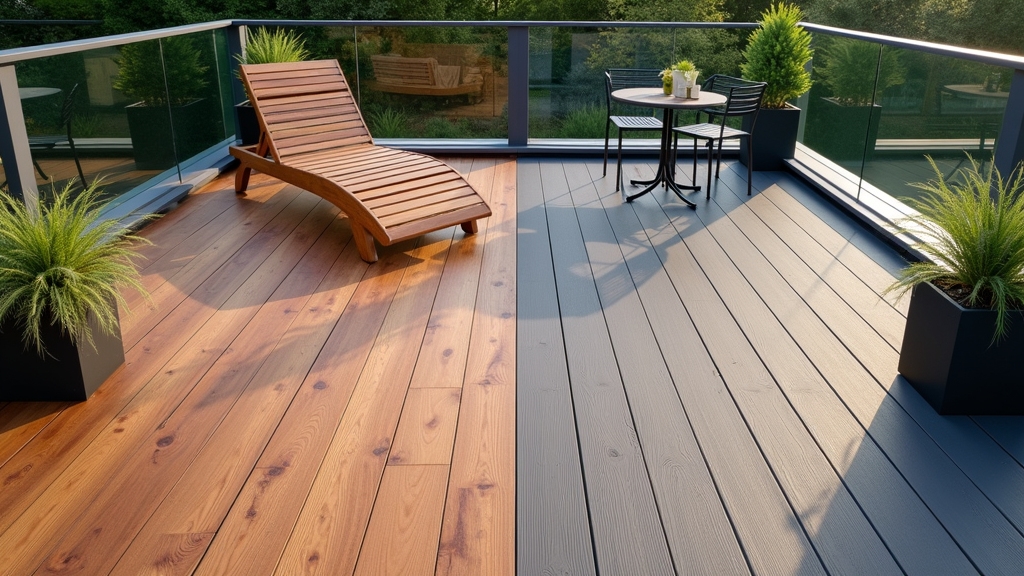
You’ll notice hardwood decking offers a rich, authentic texture and natural grain that evolves with time, adding unique character to your space. Its natural fibers provide classic warmth but require regular maintenance to preserve their appearance.
Composite decking, on the other hand, provides a consistent color palette and varied surface finishes designed to mimic wood while resisting weathering effects. Its capped options provide enhanced protection against moisture and UV damage, extending the deck’s lifespan.
Natural Wood Appeal
Three key aesthetic factors distinguish natural hardwood decking from composite alternatives: texture authenticity, color evolution, and design versatility. When you choose hardwood, you get:
- Authentic Texture: Real wood grain offers tactile warmth and unique surface variations, including knots and patina, which composite’s embossed textures can’t replicate. Proper maintenance, including gentle cleaning methods and avoiding harsh chemicals, helps preserve this unique texture.
- Natural Color Evolution: Hardwood ages gracefully, developing a weathered patina and subtle fading that adds character, unlike composite’s consistent, UV-resistant color. However, hardwood tends to change color and may warp over time, adding to its natural character but requiring more upkeep due to these color changes and warping.
- Design Versatility: Hardwood’s workability allows intricate cuts, custom railings, and hand-finishing techniques that create bespoke designs beyond composite’s uniform profiles. This versatility is enhanced by specialized cleaning and care that maintains the wood’s integrity and appearance over time.
This natural complexity delivers a premium, handcrafted look that elevates your deck’s aesthetic depth and timeless appeal, making hardwood a preferred choice for those valuing authenticity and artisanal craftsmanship.
Color and Texture Variety
Beyond the authentic texture and natural aging of hardwood, the range of colors and surface variations plays a significant role in defining your deck’s visual impact. Hardwood offers rich, natural hues like mahogany and teak, with unique grain textures that evolve over time. Avoid cleaning methods that cause surface deterioration to maintain these qualities.
Composite decking, however, provides a broader palette including earth tones and variegated finishes, ensuring consistent color and texture with minimal maintenance. Many composite options come with heat-mitigating technology, making them cooler underfoot in hot climates.
Additionally, composite materials resist sticky residues that can form from improper cleaning, preserving their appearance longer. Custom color options in composites allow you to tailor your deck precisely to your design scheme.
Environmental Impact and Sustainability Considerations
Although composite decking offers the advantage of utilizing recycled materials like reclaimed wood fibers and thermoplastics, its production demands considerably more energy and generates greater particulate air pollution compared to wood decking.
This environmental cost is important to consider in light of the susceptibility of wood fibers to compression and damage under pressure. Composite decking uses recycled materials but requires much more energy and causes higher air pollution than wood.
When weighing environmental impact and sustainability, consider these key factors:
- Composite manufacturing consumes roughly 10 times more energy and emits 26 times more particulate pollution than redwood lumber processing.
- Wood decking, especially FSC-certified hardwoods, acts as a carbon sink, sequestering CO₂ during growth and storage, reducing greenhouse gases.
- Composite plastic components persist long-term, risking aquatic habitats with eutrophication effects nine times higher than wood decking’s water pollution footprint.
However, composite decking’s long lifespan of 20 to 25 years reduces the frequency of replacement, which can decrease overall resource consumption and waste. Choosing responsibly sourced wood offers lower lifecycle emissions, while composite’s durability and recycling programs mitigate frequent replacements but don’t fully offset manufacturing impacts.
Safety and Comfort Features of Decking Surfaces
When selecting decking materials, you’ll want to consider how surface texture and slip resistance impact safety, especially in wet or icy conditions. Composite decking’s textured surfaces and non-slip additives provide better traction, reducing slip risks without extra treatments.
Additionally, composite decking is engineered to be splinter-free and safe, providing a safer surface for families and pets. In contrast, hardwood’s smooth grain can become slippery when damp and is prone to splintering, requiring more maintenance to stay safe.
Think about heat retention too. Composites may get hot underfoot, while certain hardwoods stay cooler, making barefoot use more comfortable. This can influence comfort and safety during extended outdoor use.
Weather Resistance and Performance in Various Climates
Since your decking will face diverse weather conditions, understanding how materials perform across climates is crucial. Composite decking excels in moisture resistance, preventing warping and rot even in rainy or humid environments, unlike wood which absorbs moisture and requires constant sealing.
Additionally, composites resist insect damage and fungal decay, which is essential in warm, pest-prone regions. Composite decking also offers long-term durability with less susceptibility to weather-related damage, reducing the need for frequent repairs.
When exposed to sunlight, composite’s UV-resistant coatings minimize fading and surface degradation, maintaining aesthetics longer than wood. Wood demands frequent refinishing to keep its appearance.
Consider these key points:
- Composite withstands wet climates with superior dimensional stability.
- It resists biological threats—rot and insects—better than wood.
- UV protection in composites preserves color and texture far longer.
Choosing the Right Decking Material for Your Project
Selecting the right decking material hinges on balancing cost, maintenance, appearance, environmental impact, and durability to meet your project’s specific needs. Hardwood demands a higher initial investment but offers authentic grain and natural texture, appealing to traditional aesthetics.
Choosing decking means balancing cost, care, look, eco-impact, and durability to fit your project perfectly.
Composite decking, often made from recycled materials, provides color stability, minimal upkeep, and resistance to rot, mold, and insects—ideal for long-term durability with lower lifetime costs. It is also known for being low maintenance, requiring no staining or sealing.
While hardwood requires periodic staining and sealing, composite needs only routine cleaning, saving you time and expense. Consider environmental factors: hardwood is renewable but varies by sourcing; composite supports sustainability through recycled content.
Frequently Asked Questions
How Easy Is It to Repair Scratches on Hardwood Versus Composite Decking?
You’ll find repairing scratches on hardwood more labor-intensive, requiring sanding, wood filler, and precise staining to blend with natural grain. It demands skill to avoid patchiness, and maintenance is ongoing due to weather’s effect on color.
Composite decking repairs are easier. You can use heat guns, colored fillers, or touch-up markers for quick, effective fixes. Composite scratches often fade over time, letting you save effort and maintain aesthetics with less frequent upkeep.
Can Composite Decking Be Painted or Refinished to Change Color?
You can paint uncapped composite decking, but only after thorough cleaning and light sanding, since 70% of composite surfaces resist paint due to their protective coating.
Always apply in 50°F–85°F conditions and follow manufacturer guidelines closely. This approach lets you precisely change your deck’s color while maintaining its aesthetic and structural integrity.
What Are the Best Cleaning Products for Composite Decking?
You’ll want to use DeckMAX® Composite & Wood Deck Cleaner or Wash Safe™ Spray and Clean Deck Cleaner for tough stains. They’re manufacturer-recommended and protect your deck’s integrity.
For eco-friendly options, mix 1 cup vinegar, 1 gallon warm water, and ¼ cup baking soda. Scrub gently with a soft brush. Always rinse thoroughly and test in a small area before full use.
How Do Hardwood and Composite Decking Affect Home Resale Value?
You’ll find hardwood decking offers a higher immediate ROI, returning over 60% of your investment, appealing to buyers valuing traditional aesthetics.
Composite decking, though slightly lower percentage-wise, adds more absolute value—around $9,325 nationally—thanks to its longevity, and minimal maintenance.
Its durability and modern look attract eco-conscious buyers, enhancing your home’s marketability, especially in harsh climates. Choosing designs that harmonize with your home further boosts resale appeal for both materials.
Are There Any Health Concerns With Chemicals Used in Composite Decking?
Yes, you should be aware that composite decking contains polymers with additives like UV stabilizers and colorants, which can release dust causing respiratory and skin irritation during cutting or sanding.
Certain components may pose carcinogenic risks if inhaled repeatedly. While most composites avoid PVC’s severe toxins, fire can emit hazardous gases.
Despite being free from heavy-metal preservatives found in treated wood, composite materials introduce concerns about microplastic pollution and long-term environmental persistence.
Hardwood or Composite: Your Next Steps in Choosing the Perfect Deck
Choosing between hardwood and composite decking is like selecting the perfect brush for a masterpiece—it depends on your priorities. Hardwood offers natural beauty and strength, while composite provides low maintenance and consistent durability.
Consider cost, climate, and environmental impact carefully. By weighing these factors with precision, you’ll create a deck that not only enhances your space but also stands resilient through time.
This will help you combine both form and function with expert craftsmanship tailored to your lifestyle.
- NATURAL ACACIA WOOD — Ourinterlocking wooden tiles are made from natural acacia wood with…
- SPACED DESIGN, NON-SLIP SURFACE — Wood deck tiles aredesigned with spacing between slats to create…
- TIGHT CONNECTION — Every acacia wood plank is fastened to the plastic base using mortise and tenon…
- 【Durable sturdy and Sustainable materials】: Shunhong uses high-quality sustainable polymer…
- 【Simple assembly】: Our composite decking tile features an interlocking design, allowing for easy…
- 【Low maintenance】: Just sweep with a broom or rinse with water to keep it clean. The appropriate…
Last update on 2025-12-24 / Affiliate links / Images from Amazon Product Advertising API

